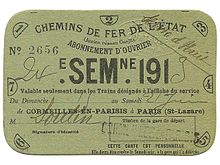Chemins de fer de l'État (France)
The Chemins de fer de l'État ( ETAT ) were the French state railway from 1878 to 1938, alongside the otherwise predominantly privately organized railway system.
history
Emergence
In 1878, the French state was forced to take over ten railway companies that were threatened with bankruptcy in order to keep their traffic going. 2,615 km of railway lines were affected, 1,575 km of which were in operation. They were spread over a third of the national territory, mainly in the north-west and west of France. It was not a coherent network, so that island businesses emerged. By law of June 11th, 1878, a loan of 331 million francs was approved, with 3% interest and running until 1953 to compensate the owners . As a rescue company for economically precarious railway companies without main lines, which were distributed over a large area and disconnected, the "ETAT" was initially of little economic importance.
expansion
The purchased routes have been expanded and new routes have been tackled. However, the state initially tended to endeavor to get rid of the loss-making operation. In 1884 he signed contracts with a number of large private railways, with which he took 17 lines belonging to him, 1,215 km in length, to the Chemins de fer de l'Ouest (l'Ouest) (877 km), the Compagnie du chemin de fer de Paris à Orléans ( PO) and other companies. In return, the companies undertook to take over the operation of local railways in their catchment area in accordance with government regulations. This relinquishment of routes reduced the number of island operations. The ETAT was further consolidated by taking over 449 km of routes from the PO. This gave ETAT a more cohesive network with a total of 2,112 km of routes. This now had two focal points: a southern with the center Tours and a northern with the center Chartres .
Also prepared by the treaties of 1884, ETAT and Ouest shared the Paris – Chartres route (88 km) from July 11, 1886 , giving ETAT direct access to Paris for the first time and opening the Grave d'Ambarès– route. Bordeaux got access to Bordeaux . This also created a connection between the northern and southern operating areas and a continuous, independent line from Paris to Bordeaux in addition to the existing Paris – Bordeaux line of the Chemin de fer de Paris à Orléans (PO). With regard to the corresponding connections, the necessary agreement was made with the PO as early as 1883. The network length of the ETAT was 2,253 km at the end of 1885 and 2,504 km at the end of 1886.
On December 18, 1908, the Ouest network was nationalized on January 1, 1909. The Ouest was in fact, if not yet accounted for , merged with the ETAT. This made ETAT one of the major French railroad companies. As a result of the merger, ETAT also acquired its own train stations in the capital for the first time with the Parisian train stations Saint-Lazare and Montparnasse . At the end of 1910, the old network of ETAT in operation covered 2,831 km, the added network of Ouest 6,068 km. The length of the entire network was 8,899 km. The ETAT often obtained its locomotives from Great Britain , from 1913 from the USA . ETAT began early to electrify the Paris suburb lines with direct current .
The End
In 1938, the ETAT was integrated into the new state railway, the Société nationale des chemins de fer français (SNCF). It now formed their western region (region 3).
See also
literature
- V. der Leyen: The state railways in France . In: Journal for Railway and Steamship. Vienna 1888, p. 469 a. ff.
- Victor von Röll: Encyclopedia of the Railway System . Volume 5. Keyword: French State Railways . Berlin, Vienna 1914, pp. 193–194.
- Stefan Vockrodt: Westbahnen and ETAT . In: Railways in Paris = Railway History Special 2 (2015). ISBN 978-3-937189-94-9 , p. 12.



